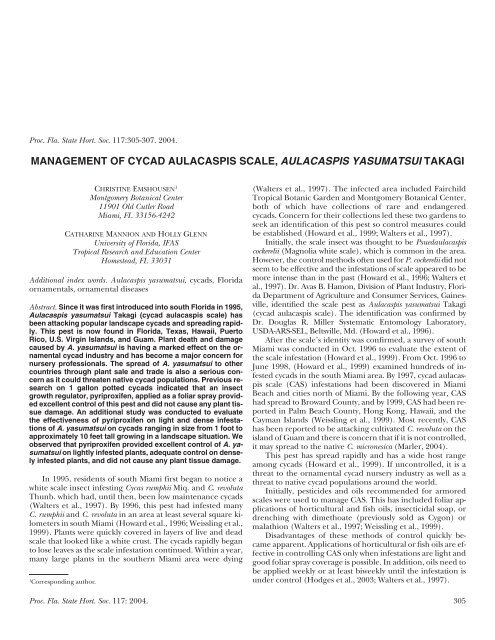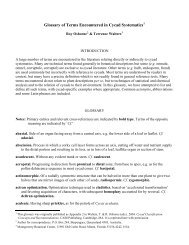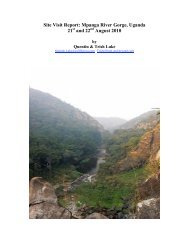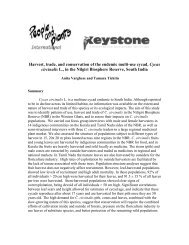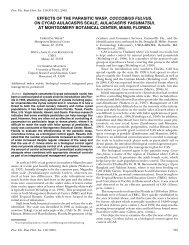Emshousen,C., C. Mannion & H. Glenn. 2004
Emshousen,C., C. Mannion & H. Glenn. 2004
Emshousen,C., C. Mannion & H. Glenn. 2004
You also want an ePaper? Increase the reach of your titles
YUMPU automatically turns print PDFs into web optimized ePapers that Google loves.
McSorley, R., K.-H. Wang, and G. Church. <strong>2004</strong>. Fumigant alternatives to methyl<br />
bromide for managing nematodes and weeds in snapdragon. Proc.<br />
Fla. State Hort. Soc. 117: (in press).<br />
Obenauf, G. L. (ed.). 2002. 2002 International Research Conference on Methyl<br />
Bromide Alternatives and Emissions Reductions. Methyl Bromide Alternatives<br />
Outreach, Fresno, CA.<br />
Proc. Fla. State Hort. Soc.<br />
117:305-307. <strong>2004</strong>.<br />
Weingartner, D. P., J. R. Shumaker, and G. C. Smart, Jr. 1983. Why soil fumigation<br />
fails to control potato corky ringspot disease in Florida. Plant Dis.<br />
67:130-134.<br />
MANAGEMENT OF CYCAD AULACASPIS SCALE, AULACASPIS YASUMATSUI TAKAGI<br />
CHRISTINE<br />
EMSHOUSEN1<br />
(Walters et al., 1997). The infected area included Fairchild<br />
Montgomery Botanical Center<br />
Tropical Botanic Garden and Montgomery Botanical Center,<br />
11901 Old Cutler Road<br />
both of which have collections of rare and endangered<br />
Miami, FL 33156-4242<br />
cycads. Concern for their collections led these two gardens to<br />
seek an identification of this pest so control measures could<br />
CATHARINE<br />
MANNION<br />
AND HOLLY<br />
GLENN<br />
University of Florida, IFAS<br />
Tropical Research and Education Center<br />
Homestead, FL 33031<br />
be established (Howard et al., 1999; Walters et al., 1997).<br />
Initially, the scale insect was thought to be Psuedaulacaspis<br />
cockerelii (Magnolia white scale), which is common in the area.<br />
However, the control methods often used for P. cockerelii did not<br />
seem to be effective and the infestations of scale appeared to be<br />
Additional index words. Aulacaspis yasumatsui,<br />
cycads, Florida<br />
ornamentals, ornamental diseases<br />
more intense than in the past (Howard et al., 1996; Walters et<br />
al., 1997). Dr. Avas B. Hamon, Division of Plant Industry, Florida<br />
Department of Agriculture and Consumer Services, Gaines-<br />
Abstract. Since it was first introduced into south Florida in 1995,<br />
Aulacaspis yasumatsui Takagi (cycad aulacaspis scale) has<br />
been attacking popular landscape cycads and spreading rapidly.<br />
This pest is now found in Florida, Texas, Hawaii, Puerto<br />
ville, identified the scale pest as Aulacaspis yasumatsui Takagi<br />
(cycad aulacaspis scale). The identification was confirmed by<br />
Dr. Douglas R. Miller Systematic Entomology Laboratory,<br />
USDA-ARS-SEL, Beltsville, Md. (Howard et al., 1996).<br />
Rico, U.S. Virgin Islands, and Guam. Plant death and damage After the scale’s identity was confirmed, a survey of south<br />
caused by A. yasumatsui is having a marked effect on the ornamental<br />
cycad industry and has become a major concern for<br />
nursery professionals. The spread of A. yasumatsui to other<br />
countries through plant sale and trade is also a serious concern<br />
as it could threaten native cycad populations. Previous research<br />
on 1 gallon potted cycads indicated that an insect<br />
growth regulator, pyriproxifen, applied as a foliar spray provided<br />
excellent control of this pest and did not cause any plant tissue<br />
damage. An additional study was conducted to evaluate<br />
the effectiveness of pyriproxifen on light and dense infesta-<br />
Miami was conducted in Oct. 1996 to evaluate the extent of<br />
the scale infestation (Howard et al., 1999). From Oct. 1996 to<br />
June 1998, (Howard et al., 1999) examined hundreds of infested<br />
cycads in the south Miami area. By 1997, cycad aulacaspis<br />
scale (CAS) infestations had been discovered in Miami<br />
Beach and cities north of Miami. By the following year, CAS<br />
had spread to Broward County, and by 1999, CAS had been reported<br />
in Palm Beach County, Hong Kong, Hawaii, and the<br />
Cayman Islands (Weissling et al., 1999). Most recently, CAS<br />
tions of A. yasumatsui on cycads ranging in size from 1 foot to has been reported to be attacking cultivated C. revoluta on the<br />
approximately 10 feet tall growing in a landscape situation. We<br />
observed that pyriproxifen provided excellent control of A. yasumatsui<br />
on lightly infested plants, adequate control on densely<br />
infested plants, and did not cause any plant tissue damage.<br />
island of Guam and there is concern that if it is not controlled,<br />
it may spread to the native C. micronesica (Marler, <strong>2004</strong>).<br />
This pest has spread rapidly and has a wide host range<br />
among cycads (Howard et al., 1999). If uncontrolled, it is a<br />
In 1995, residents of south Miami first began to notice a<br />
white scale insect infesting Cycas rumphii Miq. and C.<br />
revoluta<br />
Thunb. which had, until then, been low maintenance cycads<br />
(Walters et al., 1997). By 1996, this pest had infested many<br />
C. rumphii and C.<br />
revoluta in an area at least several square kilometers<br />
in south Miami (Howard et al., 1996; Weissling et al.,<br />
1999). Plants were quickly covered in layers of live and dead<br />
scale that looked like a white crust. The cycads rapidly began<br />
to lose leaves as the scale infestation continued. Within a year,<br />
many large plants in the southern Miami area were dying<br />
threat to the ornamental cycad nursery industry as well as a<br />
threat to native cycad populations around the world.<br />
Initially, pesticides and oils recommended for armored<br />
scales were used to manage CAS. This has included foliar applications<br />
of horticultural and fish oils, insecticidal soap, or<br />
drenching with dimethoate (previously sold as Cygon) or<br />
malathion (Walters et al., 1997; Weissling et al., 1999).<br />
Disadvantages of these methods of control quickly became<br />
apparent. Applications of horticultural or fish oils are effective<br />
in controlling CAS only when infestations are light and<br />
good foliar spray coverage is possible. In addition, oils need to<br />
be applied weekly or at least biweekly until the infestation is<br />
1Corresponding<br />
author.<br />
under control (Hodges et al., 2003; Walters et al., 1997).<br />
Proc. Fla. State Hort. Soc. 117: <strong>2004</strong>. 305
Conversely, dimethoate and malathion can more quickly<br />
control a heavy infestation of CAS although use of<br />
dimethoate or malathion has its own disadvantages. They are<br />
broad-spectrum insecticides, which can be toxic or dangerous<br />
if used inappropriately. In addition, many suppliers have<br />
stopped carrying dimethoate. Both dimethoate and<br />
malathion can cause phytotoxicity to new growth on cycads<br />
(<strong>Emshousen</strong> and <strong>Mannion</strong>, <strong>2004</strong>).<br />
In more recent years, University of Florida, IFAS researchers<br />
have evaluated some of the newer classes of insecticides<br />
for control of CAS. Research trials conducted at the Tropical<br />
Research and Education Center showed that two systemic insecticides<br />
recommended for scale control, imidacloprid<br />
(Merit or Marathon) and thiamethoxam (Flagship) did not<br />
provide adequate control of CAS (C. <strong>Mannion</strong>, University of<br />
Florida, personal communication).<br />
Pyriproxifen (Distance), an insect growth regulator, has<br />
also been evaluated and shown to provide excellent control of<br />
CAS. There are several main differences between pyriproxifen<br />
and broad-spectrum insecticides. Pyriproxifen does not<br />
provide a contact kill, but rather inhibits production of viable<br />
eggs by females, sterilizes females, and inhibits metamorphosis<br />
of immature scale. Since pyriproxifen is a narrowly targeted<br />
insect growth regulator rather than a broad-spectrum<br />
insecticide, it is less likely to disrupt any control by biological<br />
parasitoids. It is also less likely to inadvertently harm either<br />
the applicator or the immediate environment. Since pyriproxifen<br />
breaks the life cycle of the scale by preventing development,<br />
it takes a full life cycle before control of the pest<br />
can be established.<br />
C. <strong>Mannion</strong> and H. <strong>Glenn</strong> first began evaluating pyriproxifen<br />
for control of CAS at TREC in 2002. They initially experimented<br />
with foliar applications applied to C. revoluta in 1gallon<br />
pots. Female scale on leaf samples were examined under<br />
a microscope for mortality of females and eggs. Results indicated<br />
that, although pyriproxifen was slower to act in<br />
controlling CAS than some broad-spectrum insecticides,<br />
100% of eggs and 99% of female scale examined were dead<br />
after eight weeks (<strong>Mannion</strong> and <strong>Glenn</strong>, unpublished data).<br />
<strong>Mannion</strong> and <strong>Glenn</strong> have tested pyriproxifen in subsequent<br />
tests and found similar results (C. <strong>Mannion</strong>, personal communication).<br />
Following the work of <strong>Mannion</strong> and <strong>Glenn</strong>, we constructed<br />
a study examining the effectiveness of pyriproxifen on<br />
large cycads heavily infested with CAS at Montgomery Botanical<br />
Center (MBC). The objective of this study was to examine<br />
the effectiveness of pyriproxifen in controlling all life stages<br />
of CAS on large cycads in a field situation. Cycads in this study<br />
were also examined for any signs of phytotoxicity or other<br />
negative effects of chemical application.<br />
306<br />
Materials and Methods<br />
Nine plants that had the heaviest infestations of CAS at<br />
MBC were selected for study and sampling. Two samples were<br />
taken from each of the nine plants, and scale insects were examined<br />
under a microscope. The plants selected for sampling<br />
were of varying sizes, ranging from 1 to approximately 10 feet<br />
tall and varied in age from 11 to 46 years old. Species selected<br />
for sampling included primarily species of Cycas, as we have<br />
observed that this genera is the most heavily affected. Sampled<br />
species included Cycas thouarsii R. Br. ex Gaudich, C. media R.<br />
Br., C. bougainvilleana K.D. Hill, C. riuminiana Porte ex Regel,<br />
C. angulata R. Br., C. taitungensis C.F. Shen, C. edentata De<br />
Laub., and Stangeria eriopus (Kunze) Baill. With the exception<br />
of C. edentata,<br />
one plant of each species was sampled. S. eriopus<br />
was included in this study because we have observed heavy infestations<br />
of CAS on this species at MBC. MBC was selected for<br />
the location of this study because there are more than 3000<br />
cycads in the ground and available for scientific study.<br />
The spray solution was mixed at a rate of 12 fl. oz. product<br />
per 100 gal of water in accordance with the Distance label.<br />
The mixed solution was applied as a foliar spray to both surfaces<br />
of leaves, cones and trunk. The spray was applied with a<br />
300-gal high-pressure sprayer until the point of runoff.<br />
After 40 d, <strong>Mannion</strong> and <strong>Glenn</strong> removed two samples from<br />
each of the nine plants. One sample from each plant was taken<br />
from a heavily infested area, such as a leaf base, and a second<br />
sample was taken from an area with a lighter infestation, such<br />
as a distal leaflet. Twenty female scale insects were examined<br />
on each sample for mortality of the females and eggs.<br />
Results and Discussion<br />
Pyriproxifen’s ability to control female scale and eggs was<br />
encouraging. One hundred percent of female scale and eggs<br />
on the lightly infested sample of S. eriopus were dead. Of the<br />
nine samples taken from lightly infested portions of the sampled<br />
plants, six samples contained 90% or greater female<br />
mortality and female scale with all dead eggs. All samples taken<br />
from lightly infested portions of sampled plants contained<br />
at least 75% female mortality and 75% of females with all<br />
dead eggs (Table 1). Based on these results, pyriproxifen<br />
broke the scale life cycle and was able to provide a high degree<br />
of control on lightly infested areas of the plants.<br />
Pyriproxifen did not control scale as well on densely infested<br />
samples. Of the nine samples taken, two samples, S. eriopus<br />
and C. media,<br />
showed excellent control of CAS by<br />
pyriproxifen (89% or greater female scale mortality and females<br />
with all dead eggs). Five samples, C. bougainvilleana,<br />
C. angulata,<br />
C. edentata,<br />
C. riuminiana,<br />
and C. taitungensis,<br />
showed moderate control of CAS (70-80% female mortality<br />
and females with all dead eggs). Two samples, C. thouarsii and<br />
C. edentata,<br />
showed poor control of CAS (less than 65% female<br />
mortality and females with all dead eggs) (Table 2). No<br />
signs of phytotoxicity were observed on any plants treated<br />
with pyriproxifen.<br />
Control of female scale and eggs by pyriproxifen was not<br />
as consistent among the densely infested samples as it was<br />
among lightly infested samples. Control of CAS seemed to depend<br />
on the ability of the applicator to obtain good spray cov-<br />
Table 1. Percent mortality and percent females with all dead eggs from<br />
lightly infested cycad species.<br />
Plant<br />
S. eriopus<br />
C. media<br />
C. taitungensis<br />
C. bougainvilleana<br />
C. edentata<br />
C. edentata<br />
C. thouarsii<br />
C. angulata<br />
C. riuminiana<br />
Percent female<br />
mortality<br />
Percent females<br />
with all dead eggs<br />
100 100<br />
95 95<br />
95 95<br />
95 95<br />
95 95<br />
90 90<br />
85 84<br />
80 80<br />
75 75<br />
Proc. Fla. State Hort. Soc. 117: <strong>2004</strong>.
Table 2. Percent mortality and percent females with all dead eggs from<br />
densely infested cycad species.<br />
Plant<br />
C. media<br />
S. eriopus<br />
C. angulata<br />
C. bougainvilleana<br />
C. edentata<br />
C. taitungensis<br />
C. riuminiana<br />
C. thouarsii<br />
C. edentata<br />
Percent female<br />
mortality<br />
Percent females<br />
with all dead eggs<br />
90 90<br />
90 89<br />
80 80<br />
80 79<br />
75 74<br />
70 70<br />
70 70<br />
65 65<br />
40 35<br />
erage. Researchers have found that the plant architecture of<br />
cycads can sometimes prevent the applicator from being able<br />
to direct a spray to all infested portions of a plant (Hodges et<br />
al., 2003). We found that plants with branch/leaf architecture<br />
or size that made it difficult to spray all parts of the plant<br />
showed less control of scale on densely infested areas of the<br />
plant such as leaf bases. Similarly, areas of the plant that have<br />
become densely infested and have layers of dead scale on top<br />
of live scale may have made it difficult for the chemical to penetrate<br />
the layers and control the live scale. Pyriproxifen may<br />
provide the best control when plants are treated regularly to<br />
Proc. Fla. State Hort. Soc.<br />
117:307-309. <strong>2004</strong>.<br />
control scale and dead scale are washed from the plant so layers<br />
of dead scale are not allowed to build up.<br />
In the future we need to continue to examine the period<br />
of effective control of CAS after a treatment and determine<br />
the optimal application times. Additional studies are also<br />
needed to establish the effect of pyriproxifen on natural enemies<br />
and the level of control that can be obtained by using pyriproxifen<br />
and biological control organisms in an integrated<br />
pest management system.<br />
Literature Cited<br />
<strong>Emshousen</strong>, C. and C. <strong>Mannion</strong>. <strong>2004</strong>. Taming Asian cycad scale. The Cycad<br />
Newsletter 27(1).<br />
Hodges, G., F. W. Howard, and E. A. Buss. 2003. Update on management<br />
methods for cycad aulacaspis scale. Dept. of Agriculture and Consumer<br />
Services-Entomology Section.<br />
Howard, F. W., A. Hamon, M. Mclaughlin, T. Weissling, and S-L. Yang 1999.<br />
Aulacaspis yasumatsui (Hemiptera: Sternorrhyncha: Diaspididae), a scale<br />
insect pest of cycads recently introduced into Florida. Florida Entomologist<br />
82(1).<br />
Howard, F. W., T. Weissling, and D. Hull. 1996. New armored scale insect introduction<br />
in Miami area. TropicLine 9(2).<br />
Marler, T. <strong>2004</strong>. Fighting back. Pacific Daily News. 13 March.<br />
Walters, T., E. Shroyer, and L. Anderson. 1997. Scale and south Florida Cycas<br />
The Cycad Newsletter 20(1).<br />
Weissling, T. J., F. W. Howard, and A. B. Hamon. 1999. Cycad aulacaspis scale,<br />
Aulacaspis yasumatsui Takagi (Insecta: Homoptera: Sternorrhyncha: Diaspididae).<br />
Florida Coop. Ext. Service Publication document EENY-096. July.<br />
INTEGRATED PEST MANAGEMENT IN PINELLAS COUNTY NURSERIES<br />
JOHN<br />
C. A<br />
1 LLEYNE AND<br />
MARIA<br />
University of Florida, IFAS<br />
Pinellas County Extension<br />
Largo, FL 33774<br />
M. A 2 PGAR<br />
Additional index words. outreach programs, Pinellas county<br />
extension<br />
Abstract. In 2000, Pinellas County Extension embarked on using<br />
innovative methods to reintroduce Integrated Pest Management<br />
(IPM) to Pinellas County Nurseries. A web page<br />
showcasing IPM basic definitions, methods and techniques<br />
was developed and an informal outreach-teaching program<br />
implemented in 2002. In 2003, IPM pilot programs were established<br />
in collaborating nurseries. Growers had the assistance<br />
of a cooperating entomologist, visiting nurseries on a weekly<br />
basis; scouting for pests and proposing treatments following<br />
IPM principles. A database was developed to store information<br />
and monitor progress of each grower. Data regarding pest<br />
population levels and outcome of treatments were stored. In<br />
<strong>2004</strong>, Pinellas County nursery growers are successfully imple-<br />
1Commercial<br />
Horticulture Agent. Pinellas County Extension Service.<br />
2Independent<br />
IPM consultant. P.O. Box 76087 St. Petersburg, FL 33704.<br />
menting IPM programs, controlling pests, reducing pesticide<br />
output and impacting environmental sustainability.<br />
Integrated Pest Management or IPM is a combination of<br />
multiple control methods to reduce pests, while lowering the<br />
number of chemical pesticide applications. IPM has been<br />
proven to lower environmental risks and lower crop production<br />
costs (Olkoski et al., 1991). Ornamental plant growers of<br />
Pinellas County, Fla., have little knowledge of IPM or are<br />
skeptical about the outcome of implementing IPM practices<br />
in their nurseries. Successful IPM programs for containergrown<br />
plants are in place in the neighboring counties of Hillsborough<br />
and Manatee (Melton and Shyves, <strong>2004</strong>).<br />
Pinellas County Extension is committed to helping growers<br />
in the transition from traditional pest control practices to<br />
more environmentally friendly pest control. As more pesticides<br />
are banned due to environmental concerns, growers<br />
need to learn new ways to control insect and mite pests. Pinellas<br />
County Extension has devised a strategy that promotes a<br />
gradual process to implement IPM in ornamental nurseries in<br />
the county. The strategy consists of three steps: generating<br />
awareness, pilot programs, and continuous assistance to growers<br />
implementing IPM programs.<br />
Proc. Fla. State Hort. Soc. 117: <strong>2004</strong>. 307


